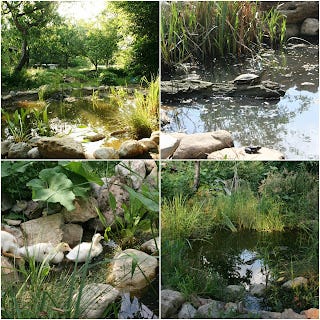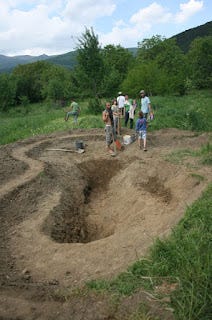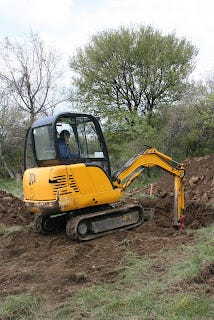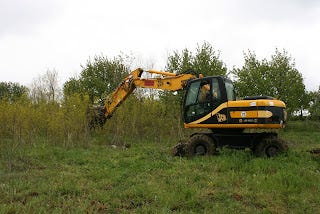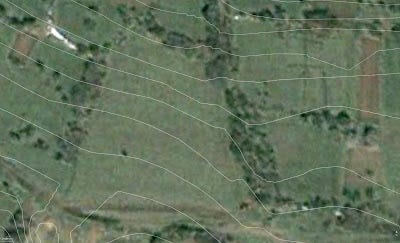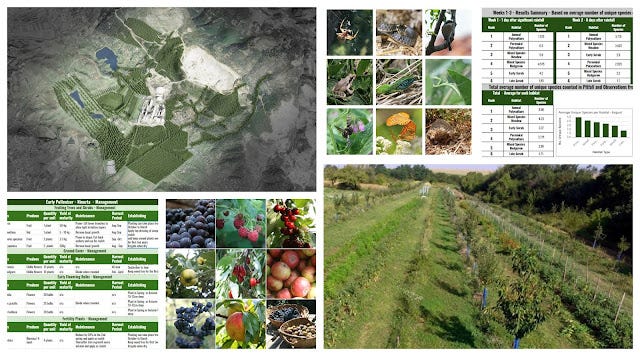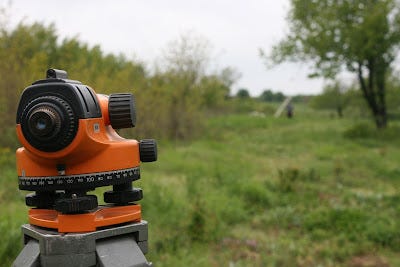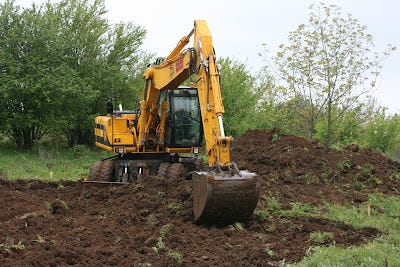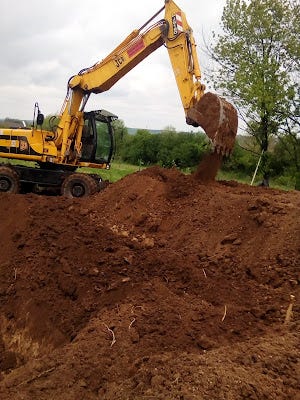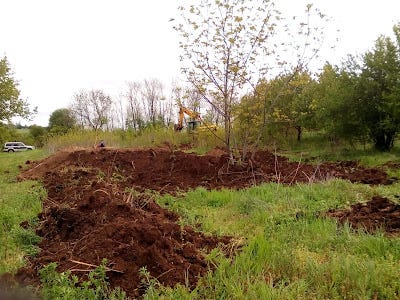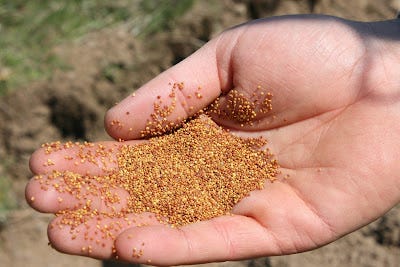We've done a couple of pond installations recently, one for our new perennial polyculture trial garden (Ataraxia) and another for a permaculture farm/orchard.
Introduction
In both the recent ponds we dug we hired a machine and driver to carry out the dig. Previous ponds we've dug by hand. With some willing help, a 6 x 4 x 1.5 m pond is very doable and I'd estimate that 3-4 people with good tools would take about 8- 10 hrs on moderately light soils, probably longer in clay.
The recent ponds we made required 3 and 4 m depths and were larger in surface area so we opted for machines. For the pond in the new garden (Ataraxia), we used a mini digger and it took us approximately 7 hours to dig 10 m x 6 m x 3.5 m. The soil is sandy silt full of smooth boulders ranging in size from basketballs to tennis balls.
The mini-digger at work in our polyculture trial garden (Ataraxia)
For Catherine's pond, we used a JCB excavator. I was planning to use a JCB backhoe but the excavator turned up and actually I was really pleased with the machine. Perhaps the front bucket on the back hoe would have cleared the topsoil a little faster but the excavator made a great job of...er.... excavating :) It took around 5 hours to dig a 12 m x 6 m x 4 m hole, level the 2 m wide pond walls, and make a 30 m inlet swale and a 15-meter spillway. The soil is heavy clay.
The JCB excavator starting the dig at Catherine Zanev's permaculture farm
So here's an overview of our design and installation process.
Pond Design and Installation Overview
Check the legalities and regulations of building a pond in your area. For ponds containing over 200 m3 of water and ponds on steep slopes with retaining walls that will bear a lot of weight, it's best to seek professional advice and guidance before you start.
Selecting a Location
Topography - Based on the topography of the site we select the optimal location for the ponds and work out the positions of the inlet (where the pond receives water) and outlet (the exit point for overflow from the pond).
Google Earth image of Ataraxia with 1 m contour intervals extracted from a Digital Terrain Map (DTM)
Pond placement in the northeast corner of the site is the highest point of the site and provides an opportunity to siphon water from the pond for irrigation. We have access to a stream that can be diverted from the N.E. to fill the pond. The beds are placed more or less on contour to ease irrigation.
Surroundings - The pond location will benefit from protection from strong winds and some shade (to reduce evaporation). Having lots of deciduous and fruiting trees around the pond will result in large quantities of leaves and fruit falling into the pond that can cause eutrophic conditions unless cleared, and digging a pond around established trees will also inevitably damage the roots of the trees.
Regenerative Landscape Design - Online Interactive Course
Want to learn how to design, build and manage regenerative landscapes? Join us on our Regenerative Landscape Design - Online Interactive Course. We look forward to providing you with the confidence, inspiration, and opportunity to design, build and manage regenerative landscapes, gardens, and farms that produce food and other resources for humans while enhancing biodiversity.
You can access the course material at anytime and join the live sessions and interactive forums that run from May - Oct every year. All members of the Bloom Room receive a 500 EUR discount. To take up this offer all you have to do is become an annual subscribers to our Substack and register here with the promo code BLOOM.
I look forward to you joining !
What is the pond for?
Clarifying your objectives for having a pond is important and determines the shape and size of the design.
If you would like to encourage wildlife you will need to provide various depths within the pond to cater to a range of aquatic plants and you'll need a gentle slope for animals to enter and exit. Eventually, adding some features such as tree stumps or hollow rocks to the pond will provide hiding places for fish and other pond life and basking territory for amphibians.
The four categories of plants that should be present in a wildlife pond are Emergents (Marginal Plants) - Deep Marginals (Rooted Floating Plants) - Oxygenators (submerged plants) - Floaters (free-floating plants)
Installing a pond is probably the single most effective thing you can do in a garden to enhance biodiversity and wildlife and the majority of the wildlife that will be attracted to the pond will be of great benefit to your garden or farm, i.e pollinators, and pest predators. For a wildlife pond, a maximum depth of 1.3 - 1.5 m is adequate. At this depth, most aquatic organisms including European carp -Cyprinus carpio can survive the winter.
If you need the pond for irrigation and do not have another source of water available it's best to dig deeper both to store more water and to moderate the water temperature to reduce the evaporation rates. Deep water stays cooler for longer and moderates the temperature of the surface water and water in the shallows will warm much faster and evaporate quickly.
Sketching the Pond Design
I make a few simple drawings showing the boundaries and dimensions including an overhead view and a cross-section of the width and length. This helps clarify how the pond will look and function. If using a hired machine/driver these sketches will also help communicate your vision.
The below sketches are for the pond we installed at Catherine Zanev's farm where the objective was to store rainwater from surface runoff during storm events for irrigation, but also to provide habitat for a range of wildlife and aquatic plants, hence we included shelves and beaches in the design.
Marking the shape of the pond and where the depth changes occur on the land also really helps. A long rope works well for this as do stakes connected with string or spray paint.
Welcome to our Online Store where you can find Forest Garden/ Permaculture plants, seeds, bulbs, and Polyculture multi-packs along with digital goods and services such as Online Courses, Webinars and eBooks. We hope you enjoy the store and find something you like. It's your purchases that keep our Project going. You can also find our full list of trees. shrubs and herbs for forest gardens on our website here. Enter Our Store Here
Installation Day
Pegging out - Get on-site well before the machine arrives and mark clearly all relevant features of the pond such as the perimeter, the width of the wall, the path of the inlet and spillway, the locations of depth variation, and the highest and lowest points of the land that the pond will be placed.
Planning Soil Deposits - Select an area where the top soil and excess subsoil can be stored. Most of the subsoil can be used for a wall on the lower section of the pond (if working on a slope) or as a bank around the perimeter of the pond if working on level ground and your potential water source is higher than the wall height. In some cases, you may have excess soil. Have a plan for where to put it and how you will get it there.
It's also worth planning the route for the machine to enter and work in to avoid soil compaction and damage as much as possible and to restrict this to as small a space as possible.
Communicate the plan - When the driver arrives explain exactly what you want to do and why you want to do it as clearly as possible before work begins. An experienced operator will most probably have a good understanding of the fundamentals and may be able to offer some advice so it's a good idea to invite the driver's opinion.
Remove Top Soil - First off remove the topsoil from the pond area and from the area around the pond where the wall will be placed, The top soil is very valuable and can be used to dress the excavation at the end, helping to hasten revegetation. It can also be used in another area of the garden/farm.
30- 40 cm of topsoil is removed and stored separately for later use Start digging from an outside edge and dig down to the deepest part of the pond to assess the soil profile and depth. It may be you have planned a 4 m depth but hit bedrock after 3 m. Once you have established the depth you can start to distribute the subsoil to build up the lower sides of the pond. The excavator made a great job of compressing the various layers of soil that were piled up on the edges with the flat side of the bucket. A 2 m wide wall base is very secure for a pond of this size (12 m x 6 m x 4 m).
Get the levels right - If your water input is at ground level remember the highest level the pond water will reach will be no higher than the input source and once the pond fills to this level it will start to back-flood.
An overflow route that will slowly disperse the water should be implemented. For the above pond design, we lowered a section in the wall to disperse overflow into a 16 m swale that runs just slightly off-contour into the adjacent fields.
Having a transit level on-site you can quickly check levels as you go to make sure the walls are high enough and that the overflow is where it should be.
We used the topsoil to build a berm slightly off-contour to disperse any potential overflow water into the fields.
For any earthworks that we are sure won't be disturbed in the near future we re-apply the topsoil and sow with a cover crop. In this case, we used Trifolium repens - White Clover at a rate of 1.5g /m2 for the inlet and outlet swales.
Following the dig, the deposited soil will sink and settle over the next few weeks. A few heavy rains will encourage the settling of the soil. After the soil has settled, we check the levels again and make any necessary adjustments before lining the pond.
In the following post, we'll look at liner options, how to install a liner, planting out the pond, landscaping the pond banks/earthworks, and pond maintenance. - Small Pond Installations for Irrigation and Wildlife - Part 2
Support Our Project
If you appreciate the work we are doing you can show your support in several ways.
Become a member of the Bloom Room. A $70 annual subscription to our Substack provides you with access to live sessions, design tutorials, a members forum and more, see details here.
Make a purchase of plants or seeds from our Nursery or Online Store
Joining us for one of our Practical Courses or Online Courses
Comment, like, and share our content on social media.
We offer a diversity of plants and seeds for permaculture, forest gardens, and regenerative landscapes including a range of fruit and nut cultivars. We Deliver all over Europe from Nov - March. - Give a happy plant a happy home :)




